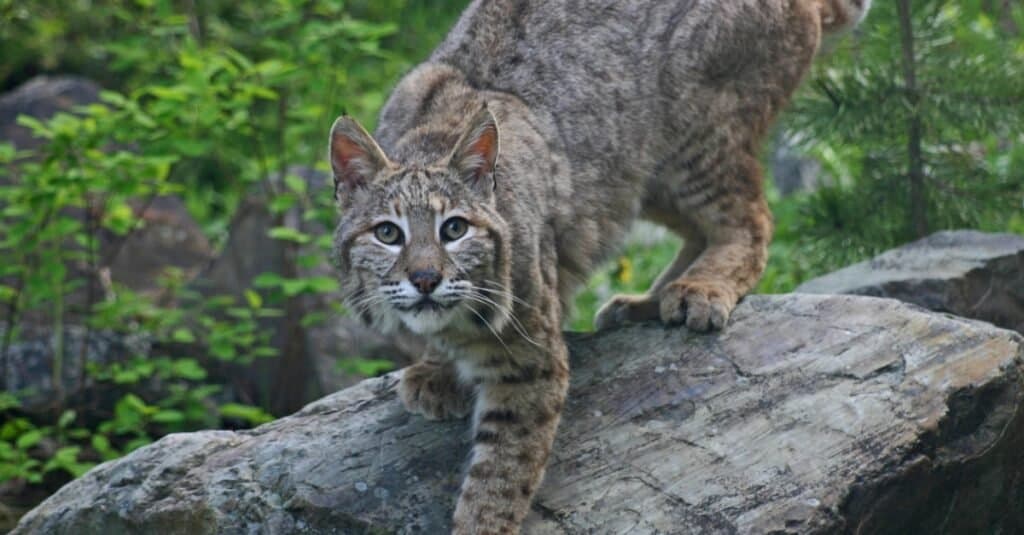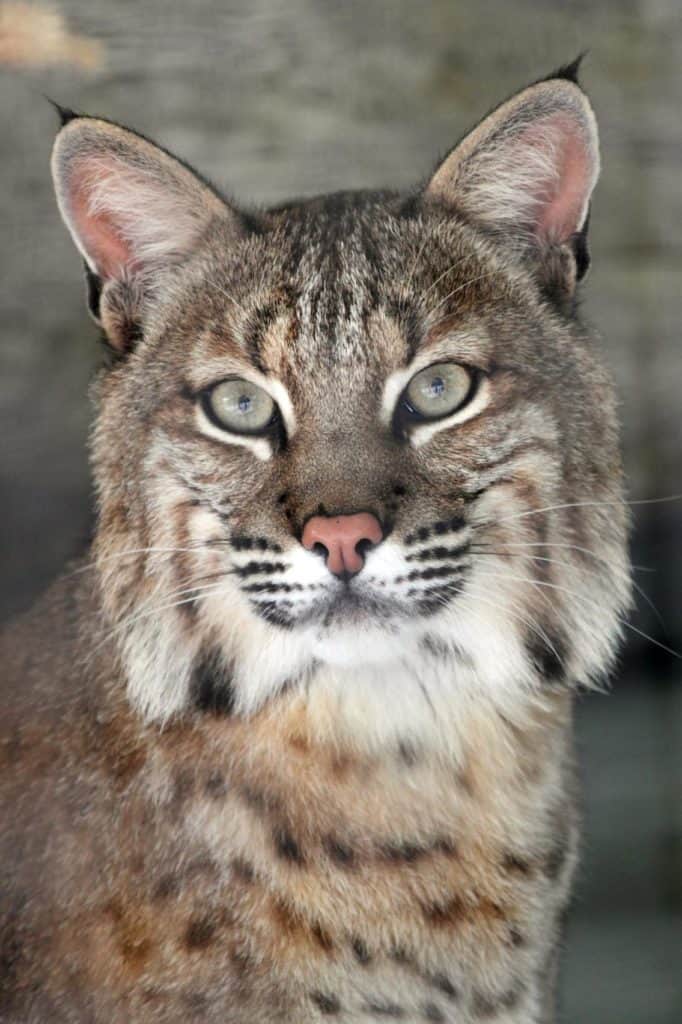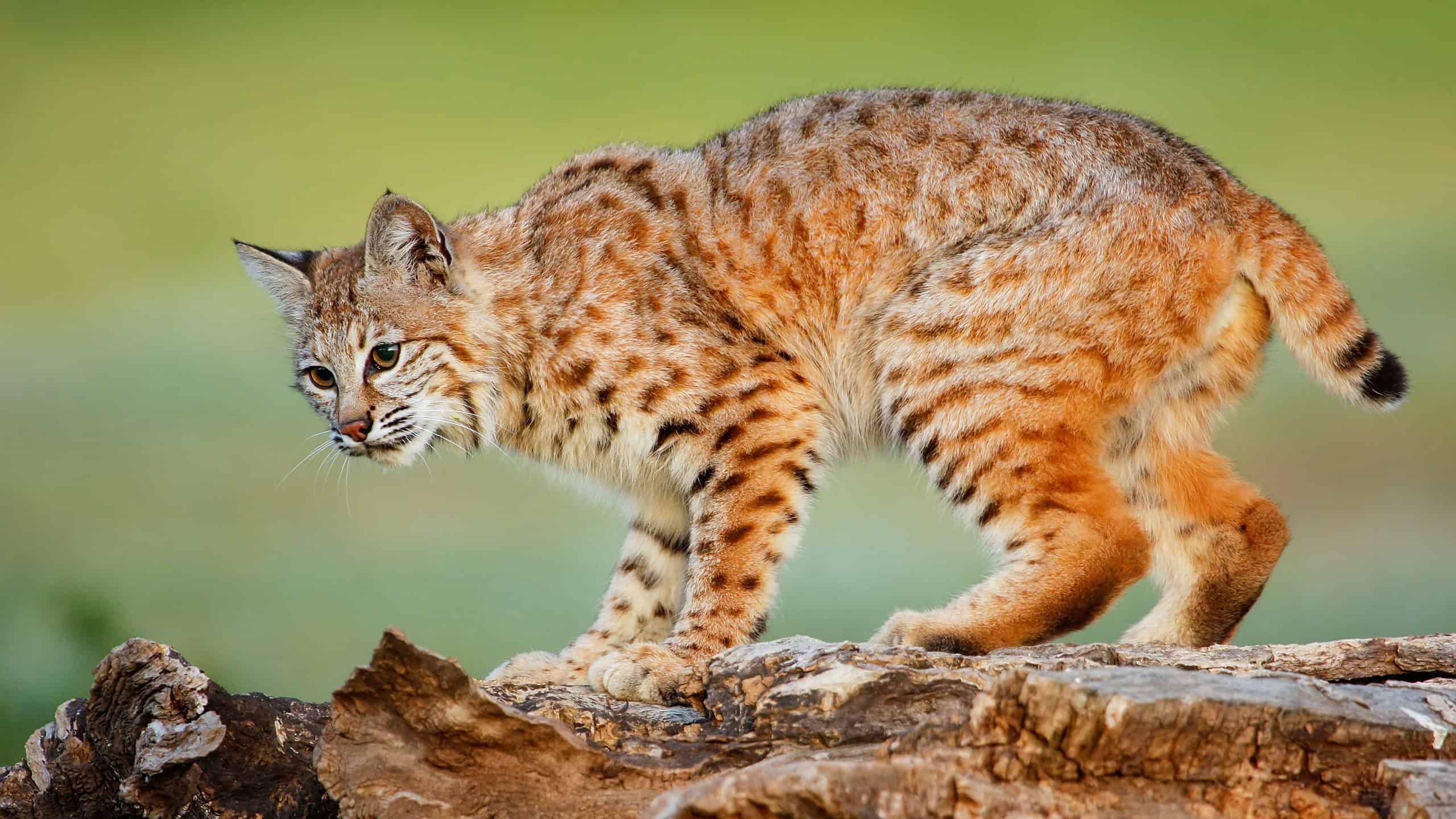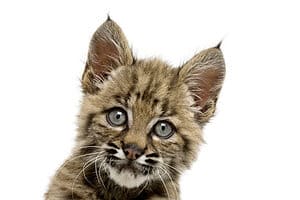Did you see a bobcat in your backyard?
When these wild cats roam into a neighborhood, people wonder, how dangerous are bobcats? Belonging to the lynx family, bobcats are known to be shy, solitary animals. But what if you find yourself face-to-face with one? Will it try to attack you? Follow along as we find out if bobcats attack humans and why.

Bobcats are the same size as big fluffy domestic cats, weighing up to 20 lb.
©Laurie E Wilson/Shutterstock.com
Will Bobcats Attack People?
Bobcats don’t usually attack humans. One of the reasons is their small size. These wild cats aren’t like big mountain lions or Florida panthers.
A typical bobcat only weighs between 15 to 40 lb. Sometimes bobcats are the same size as big fluffy domestic cats, weighing up to 20 lb. (or more if you’re this big cat).
These medium-sized carnivores don’t dine on large prey. Instead, they eat small animals such as rabbits, birds, squirrels, rats, and chickens.
How to Identify a Bobcat

Bobcats usually have a coat that ranges from a brown-orange color to a light gray.
©iStock.com/Anita Elder Design
Was the big cat you saw in your backyard a bobcat? It’s easy to mistake large feral cats or small mountain lions for bobcats. But once you know what to look for, you’ll be able to tell these wild cats apart.
A bobcat has the following features:
- Short, bobbed tail
- White spot on the back of the black ears
- Wide flat face
- Long legs
- Large paws
The first thing to look for is a short bobbed tail. A bobcat’s tail is usually 4 to 8 inches, but it can be up to 10 inches long. The tails almost always have a black tip.
Bobcats usually have a coat that ranges from a brown-orange color to a light gray. They also have black spots and/or bars on their body, though they’re most noticeable on the legs.
The fur around their face usually puffs out right by the cheeks and extends through the ears. This is called the ruff. Some bobcats lick their ruff, giving them a less puffy look.
What Attracts Bobcats to Yards?
When a bobcat is visiting your backyard, it’s because there’s a resource you’re providing. Something about your backyard may be inadvertently giving the bobcat access to food, shelter, or water.
Here’s what may attract bobcats to your backyard:
- Bird baths
- Pools
- Fountains
- Water for livestock
- Food for livestock
- Space underneath decks
- Thick brush and shade
- Unoccupied yards to sunbathe
- Unattended small pets
Bobcats don’t usually attack people, but they will attack and eat small pets and livestock. If you’re worried about the animals around your home, you can take a few simple steps to keep the bobcats out of your yard.
Discouraging Bobcats From Returning
Be careful when feeding pets and livestock. Don’t leave extra food on the ground or unattended pet food. Excess bird seed or half a bowl of dog food can lure a bobcat into your yard. Even fallen fruit can attract unwanted wildlife. Check daily to ensure your yard is free of food sources.
Bobcat Proof Fence
Will a fence keep bobcats away? It’ll have to be pretty high! Bobcats can jump up to 12 ft without any trouble.
You’ll need a fence at least 6 feet high, and the top will need a 45° angle with a 16-inch width. And the bottom of the fence will need to extend about one foot below ground level.
What to Do if You See a Bobcat

When bobcats spot humans, they usually run away.
Bobcat encounters are usually brief. Once the cat spots you, it’ll likely flee, leaving you with nothing but a fun memory. But just in case the wild cat doesn’t flee, make sure you know what to do.
Here’s what to do if you see a bobcat:
- Don’t run
- Make noise
- Face the bobcat
- Never approach a bobcat
Bobcats are skittish. If you wave your arms and yell, the cat will probably run away before you can check if the tail is bobbed. If the bobcat starts to approach you, something’s wrong. Wildcats that approach people are likely human-conditioned or sick.
Rabid Bobcat Attacks on Humans
If a bobcat begins approaching you and seems inebriated, it might have rabies. Sometimes animals appear drunk or disoriented after contracting the rabies virus. Other times the rabid animals are vicious and in full-on attack mode.
A resident of Saddlebrooke, Arizona, was attacked by a bobcat that authorities believe was rabid. Since they couldn’t trap the big cat to test him, the man had to undergo a full round of rabies treatment just to be safe.
How likely is it that you’ll encounter a rabid bobcat? The chances are low. Bobcats are one of the least likely animals to carry rabies.
Up Next
Thank you for reading! Have some feedback for us? Contact the AZ Animals editorial team.








